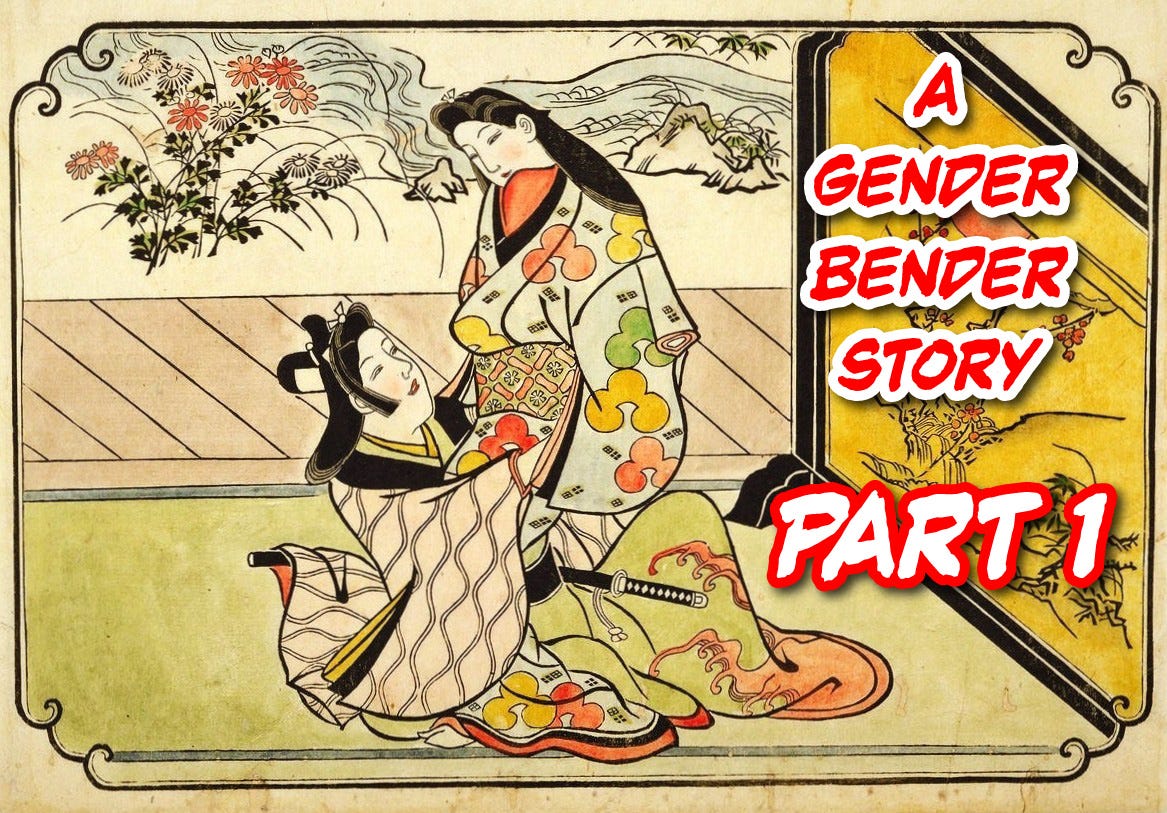Torikaebaya Monogatari: The Epic, Raunchy Gender Bending Story of Early Japan (Part 1)

"Repulsive and filthy—much of it is unreadable." That was how a critic from the Meiji era (1868–1912) described the 12th century classic Torikaebaya Monogatari (とりかへばや物語), which translates to The If-only-I-could-exchange-them Story. Judging from that critic’s review, it is an utterly vile story.
Perfect.
The original is four volumes, so I’m giving you a heavily condensed retelling. Short and sweet. Like me.
The tale starts with the Sadaijin (左大臣, “Minister of the Left”) who has two children by his two wives: a boy and a girl. Wakagimi (若君, “son of a lord”) and Himegimi (姫君, “daughter of a lord”) look almost like twins, and are beautiful and lovely and clever and all the usual fairy-tale things.
To the consternation of their conservative boomer dad, the two spawn act like the opposite gender. Wakagimi is shy and easily embarrassed, hides from visitors, enjoys painting, plays with dolls, cries easily, and seems content with earning 70 cents to the yen. Himegimi is mischievous, likes to kick balls and shoot arrows, recites poems in the Chinese style, and hangs artwork of scantily clad geisha leaning on fast ox-drawn carts on her bedroom wall.
To fit in with Heian Japanese culture, Wakagimi decides to live as a girl, Himegimi as a boy. The father gives the novel its unwieldy title by bemoaning, “If only I could exchange them, my son for the daughter and my daughter for the son!”
Somehow, the two manage to make it through puberty with only their parents knowing their birth genders (the servants too, but no one counts them because we all know servants aren’t really people), but when they are introduced to society as their chosen genders, things quickly get very wild and very complicated.
Himegimi excels in everything young courtiers are supposed to be good at: music, poetry, calligraphy, philosophical and political discourse, etc. (The narrator can’t resist adding “even though he was actually a girl” here—it’s hard to distinguish sarcasm from sexism 1,000 years later.)
Himegimi is the most beautiful, most talented, and most everythingest young man at court and spends time being hounded by thirsty court ladies, all eager for some of that androgynous amorous action. Nobody seems bothered by the fact that Himegimi disappears from court every four weeks to go bleed in peace in a remote village.
Witnessing the boy’s perfect masculinity, the Sadaijin’s brother becomes quite eager to have Himegimi marry his daughter Yon no Kimi (“fourth daughter”). Now Himegimi is not into girls, but she’s also not into being a girl, so she graciously agrees to the marriage. The new bride wonders why her husband is so sweet, understanding, unwilling to sexy-time her, and liable to disappear for four or five days every month.
Meanwhile, the brother Wakagimi is up to his own shenanigans. To see what he’s doing, tune in next week for Part 2. Same bat time, same bat channel.
Torikaebaya Monogatari: The Epic, Raunchy Gender Bending Story of Early Japan (Part 2)
The next part of our epic story.
References
Pflugfelder, Gregory M. “Strange fates. Sex, gender, and sexuality in Torikaebaya Monogatari.” Monumenta Nipponica, Vol. 47, No. 3 (Autumn 1992), pp. 347–368. http://www.jstor.org/stable/2385103
Willig, Rosette F. (translator). The Changelings: a classical Japanese court tale. Stanford UP, 1983.



This story sounds awesome. Is it a drama or a comedy? I could see it going either way.